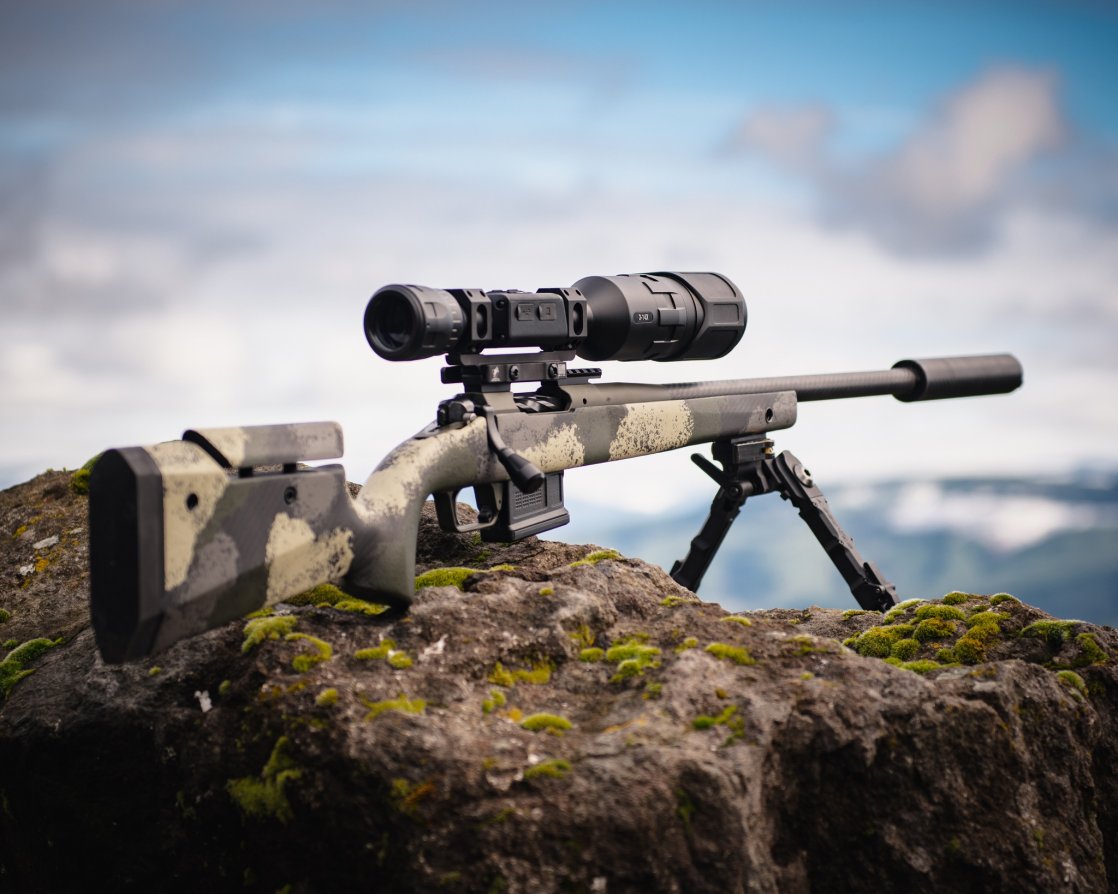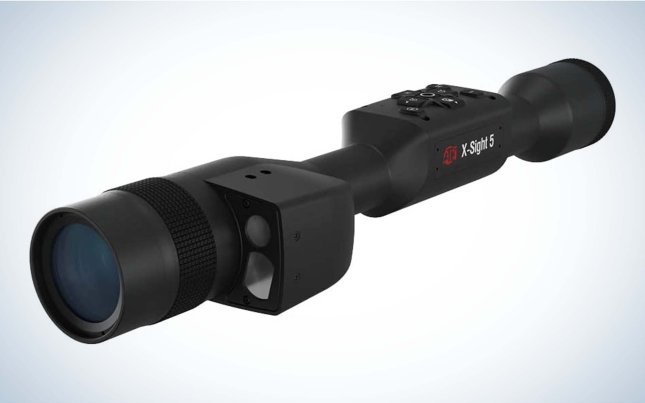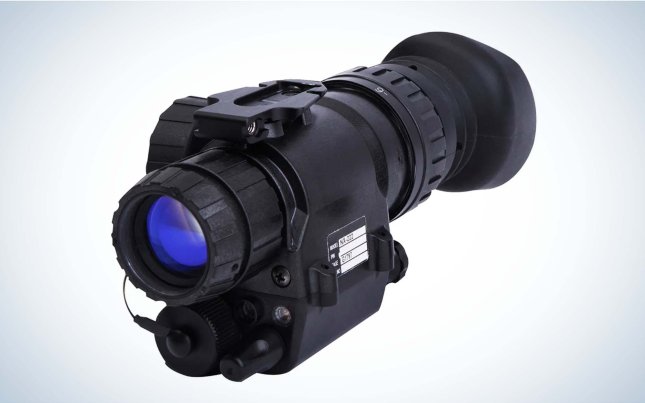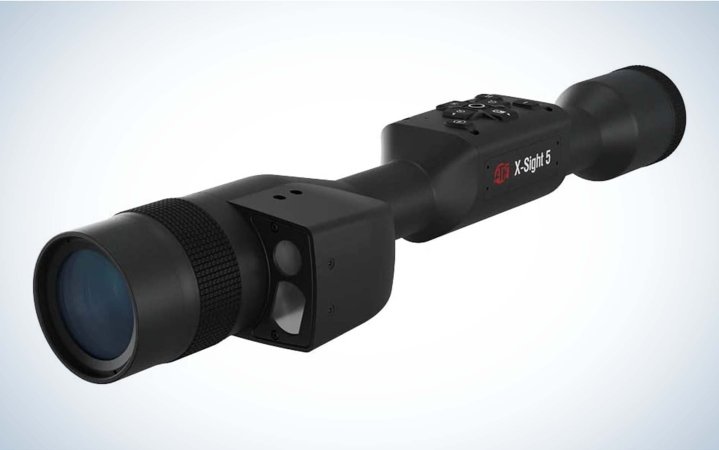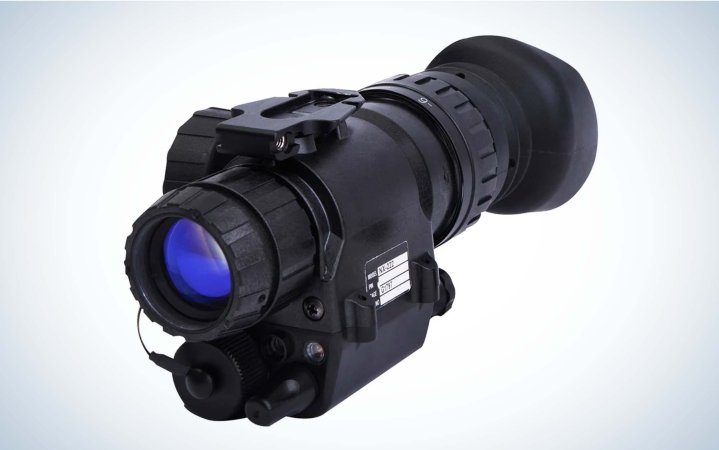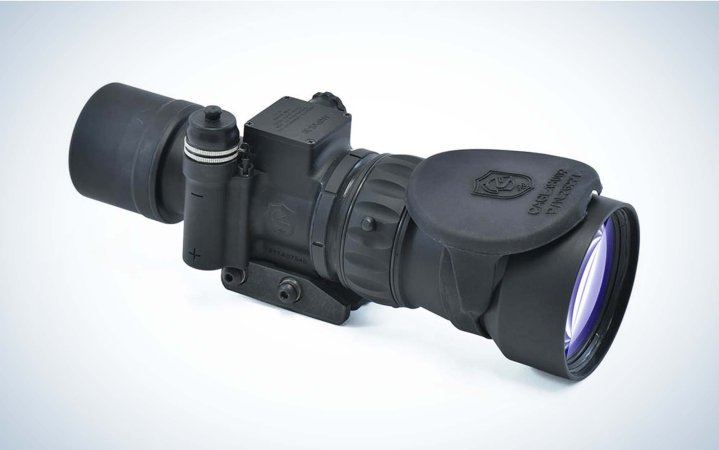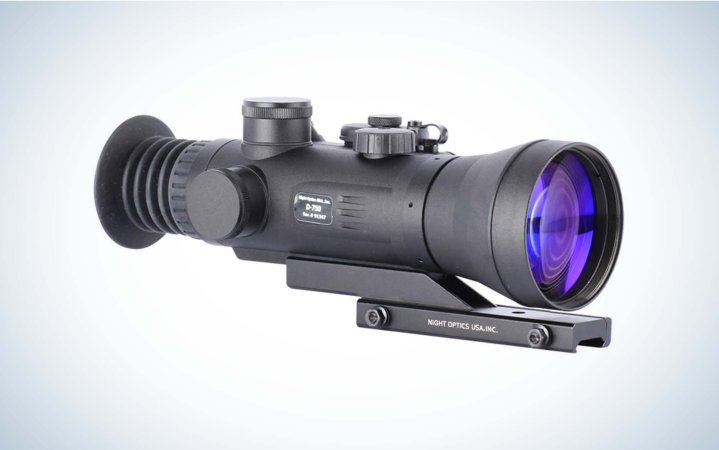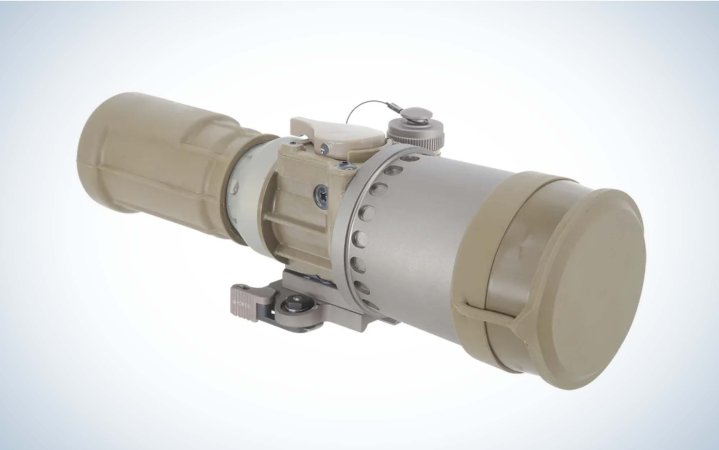We may earn revenue from the products available on this page and participate in affiliate programs. Learn More ›
Jamey Caldwell has spent thousands of hours working with night vision devices—in war and for hunting feral pigs. He spent 21 years in the US Army, with the first seven serving in the 75th Ranger Regiment and 14 in a Special Missions Unit. He’s conducted over 500 direct action raids in his military career and now through his company, 1 Minute Out, he teaches law enforcement and government agencies different tactics, including the use of night vision devices.
You’d be hard pressed to find someone more qualified to break down the best night vision scopes available to civilians. But before you get too excited about night vision, Caldwell will tell you that thermal scopes trump night vision scopes in almost any situation.
“My money is always on thermal anytime I go hunting at night—it’s always on thermal,” Caldwell says.
But, he notes, there are still many that prefer night vision scopes for hunting, and there’s a variety of devices available for that. Some other experts actually prefer night vision to thermal scopes, too. What works best for you will come down to your budget and your hunting preferences. I interviewed a couple night vision experts to get you started on finding the best night vision scope for you.
- Best Budget: ATN X-SIGHT 5 LRF 5-25X
- Best Multi-Use: EOTech MonoNV, Night Vision PVS-14
- Best Clip-on: AN/PVS-30 Knight Vision Weapon Sight
- Best for Short Range Shooting: D750 Marauder 4X GEN3
- Best for ARs: EOTech / L3 CNVD-LR (M2124-LR) Clip-On Night Vision
Night Vision vs. Thermal


Put simply, night vision scopes convert and amplify photons of light, which means they require some degree of ambient light to function. Thermal scopes work by detecting temperature via recognizing and capturing different levels of infrared light through sensors on the scope. It displays the IR light as a thermogram (in other words, what you see in your scope). Think of it like the Predator’s vision he uses to take on Arnold Schwarzenegger and his heavily armed team.
Caldwell says thermal scopes highlight the animal from farther away, and make critters almost impossible to miss. Whereas with a night vision scope, you could miss the animals if you aren’t used to the black and white or green picture that it presents.
Caldwell says a combination of night vision goggles and a thermal scope, or an integrated night vision and thermal scope can make a formidable combination for hunting. But ultimately, he recommends thermal scopes over night vision.
“I’ve used very, very high end thermal stuff on the military side,” Caldwell says. “Now I’m seeing a lot of that technology and some really great gear come out on the civilian side.”
Not all experts agree. Greg Coker served in the US Army for 22 years, with 15 years in the 160th Special Operations Aviation Regiment. He has over 6,200 flight hours flying under night vision goggles and over 1,500 hours in combat. Coker says it depends on the quality of the scope you are using, and he prefers his Gen 3 PVS-14 for it’s better target identification. Coker says it comes down to the hunter behind the gun.
“100% of it is the ability to identify what you’re going to shoot, and that’s based on weather, humidity, range—all those things come into play,” Coker says. “But, the dumbass behind the rifle needs to know for sure what they’re engaging.”
Coker takes people pig hunting at night quite often, and he regularly corrects people using thermal scopes. They’ll see an animal pop on their thermal device and immediately think it’s a pig, but often they’re looking at deer or raccoons.
Range
Thermal scopes are rated for up to 4,000 yards, whereas a night vision scope is commonly restricted to 1,000 yards or less. But Coker’s point remains valid when it comes to the range of either scope: it comes down to how good the person behind the trigger is with identifying their targets.
Cost
Night vision scopes range from budget-friendly to expensive, and most of the time you get what you pay for. The same goes for thermal scopes, but the most basic models run you more than your basic night vision scopes. A night vision scope can be as low as $200 while a basic thermal scope is around $500. A common factor for both night vision and thermal is the age of the devices greatly impacts performance. The older the equipment, the lower the resolution of your image.
Versatility
Most night vision scopes are for nighttime only. Using them during the day will damage the optic and incur expensive repairs. Thermal scopes can be used during the day, but two “crossover” periods in a day render them blind. Crossover commonly occurs during sunrise and sunset, when most natural objects approach the same temperature, causing them all to blend together for a thermal.
Thermal scopes don’t require any sort of laser or an illuminated reticle, whereas night vision scopes need an infrared laser—sighted in with the scope—or an IR illuminated reticle on the scope.
No matter what kind of technology you’re using, taking a shot at anything without 100% confirmation of your target is irresponsible. When deciding what kind of scope you want, consider the different pros and cons of each, just like you would when selecting a rifle for deer hunting, or a broadhead for your elk hunt.
Read Next: Best Thermal Scopes
Night Vision 101
Night Vision devices are classified by generations, which are defined and regulated by the US Government. Each generation—called Gen 0, 1, 2, or 3—has technological advancements the previous generation does not. Hence, the older the night vision you have, the lower the quality will be. The experts I interviewed recommended buying Gen 3 or newer (Gen3 plus) night vision.
With the advancements in technology, night vision scopes can function in low light environments, but they generally can’t function alone. So when you invest in a night vision scope, it’s likely not the only thing you will need to buy. With the more affordable night vision scopes, you’ll also need to purchase an IR-enabled crosshair or an IR laser to get accurate rounds on target.
Best Night Vision Scopes: Recommendations
Best on a Budget: ATN X-Sight 5 LRF 5-25X
Pros
- 2 year warranty
- Budget friendly option
- Customer service is quick to address any issues
- Laser range finder with auto-adjustments
Cons
- Controls are on top of the scope and you have to break sight picture to adjust
- Can have a variety of glitches in the firmware
Key Features
- $1,195
- ATN ‘Gen 5’ digital scope.
- Recognition range up to 150 yds with a standard IR light.
- Digital screen
- Option for plug-in extended battery
- User customizable reticle
- Day and night modes
For those looking to make a small investment to check out a night vision scope, the ATN X-Sight 5 is a budget friendly option. The scope’s different modes allows for day or nighttime hunting. The 4K+ sensor allows a display of 4056×3040. With recoil activated slow motion, you can capture your hunts at point of impact.
ATN’s X-sight 5 LRF operates in extreme temperatures at -20 to 120 degrees. This scope totes a 5-25x magnification, but several reviews state the higher magnification is poor quality. At 2.2 pounds and 15.2 inches long x 3 inches wide x 2.2 inches high, this scope won’t weigh down your rifle too much. I recommend that you replace the scope rings with higher quality ones to avoid any issues common with ATN’s provided rings.
Recording options of 30, 60, and 120 frames per second allow for regular or slow motion filming. ATN has built in a wifi transfer capability so you can share your videos and photos with you friends. Its built-in laser range finder will automatically adjust for windage and distance.
As stated up above, the lower the price point increases the likelihood of quality issues, but you are covered under a two-year warranty and ATN’s rockstar customer service team when you purchase this scope.
Best Multi-Use: EOTech MonoNV, Night Vision PVS-14
Pros
- 2376 minimum FOM
- Compact and lightweight at 10.6 oz
- Water resistant down to 66 ft. up to one hour
- Meets the rigorous testing of the US Military’s Mil-Std 810G
Cons
- Needs a scope with an IR crosshair or an IR laser
Key Features
- $4,999
- Gen 3
- Recognition range: With good conditions, man size target at 100-150m
- Quick-Release dovetail mount
- Gen3 technology.
- Adjustable diopter of +2 to -6
- 1x scope.
- Automatic Brightness Control and Bright Light Cut-Off
Another reliable product from EOTECH with a price point of $4,999, the PVS-14 provides flexibility that meets the military’s highest rugged standards for their equipment (MIL-STD-810G). This is Coker’s go-to setup. He’s attached it to his crossbow, shotguns, and rifles since 2008. He’s yet to experience any failures.

The PVS-14 can be hand-held, helmet or head-mounted, and weapon mounted. Its ESA Gen 3 White Phosphor tube technology provides a clear picture at night and will maintain a zero with your preferred anytime optic. At 10.6 oz. and 4.6 in. long x 2.1 wide x 2.9 high, this OG night vision clip-on won’t weigh your pack down.
Its diopter range of +2 to -6 and a minimum focus range of 9.8 in. allows for the use to dial in their sight picture for a shot on a coyote or to pick up important documents off a table.
Coker says he will use his PVS-14 over any thermal scope. His first crossbow pig was shot through a T1 Aimpoint red dot and the PVS-14.
“I posted a picture on social media, and everybody went crazy over it,” Coker says. “They’re like, ‘You got to be the first dude in the world to get a night vision bow kill on a pig!’”
Typically under good conditions a 1x image intensifier tube system will allow detection of a man-size target at 100-150 meters and recognition of a man at 80-100 meters. With the aid of a quality illuminator you can safely triple the detection range and double the recognition range, provided the user’s eyes are capable and the device is properly focused and utilized.
Best Clip-on: AN/PVS-30 Knight Vision Weapon Sight
Pros
- .5 MOA.
- Recognition range out to approximately 1,094 yards
- Gen3 technology
- Manual gain and focus control
Cons
- Heavy at 2.9 pounds
- Custom order; delayed shipping
Key Features
- $11,495
- Gen 3
- Recognition range relies on the daylight optic it’s attached to
- No rifle or optic alteration required
- KAC mount or quick attach /detach to MIL-STD-1913 rail or equivalent.
- Optimized for medium and long range scopes up to 20x
- Rated for large caliber sniper rifles up to .50 caliber
With a price point of $11,495.00, the AN/PVS-30 Knight Vision Weapon Sight is a top of the line clip-on night vision sight. Its .5 MOA enables extreme precision that snipers in federal and military units seek out. You won’t need to make any adjustments in eye relief or the position of your cheek weld as it mounts to the front of your prime optic.
The AN/PVS-30 clip-on module is optimized and tested for medium and long-range sniper weapons, including .50 caliber rifles and scopes with magnification up to 20x. At 2.9 pounds and 9.6 inches long, this will add some weight to your rifle but it’s not much different from other clip-on options—something to keep in mind.
The focus range spans 20 meters to infinity and the on/off gain control and focus ring allows the user to dial in their desired clarity. This clip-on is powered by one AA battery that grants more than 24 hours of continual use; or one 123 battery that grants 36 hours of continual use. If you are looking to make a major investment in a clip-on night vision sight, this is the one for you.
Best for Short Range Shooting: D750 Marauder 4X Gen 3
Pros
- Adjustable dual throw-lever mechanism for quick attach/detach function
- 2 year warranty
- Detection of target out to 1,000 meters
- True target identification at 350 meters
Cons
- Limited inventory (backorder currently)
- 4 lbs.
- No daylight hunting
Key Features
- $5,595.00.
- Gen 3
- Recognition range of 350 meters
- Matte black finish that minimizes light reflection.
- 4x magnification
- High definition multi-coated lenses for ultra-clear resolution
- Manual gain control
- Auto-gated
- Resolution 64-72 lp/mm
The D750 Marauder 4x Gen3 night vision scope is a top contender on the market for nighttime optics. With a price of $5,595.00, it’s middle of the road in terms of cost. The housing of the scope is waterproof, nitrogen purge-capable, and will hold a zero regardless of the recoil of the rifle it’s attached to. The D750 Marauder is rated for use with up to a .50 BMG. It has a 2-year warranty, you won’t have to worry about early repairs.
Its Gen3 technology provides a pristine picture, giving you all the power in the world to get a fast ID on feral pigs or coyotes. It features a night vision enabled crosshair so that you won’t need a laser on your rifle.
The scope is 9 inches long x 3.5 inches wide x 4 inches high. Weighing only 2.38 pounds, it provides a 4x magnification, a 10-degree view, and a resolution of 64-72 lp/mm typical. The scope has a matte black, corrosion-resistant coating and is waterproof. Its diopter range of +3 to -4 provides focus abilities for those with corrective lenses; its focus range is 33 feet to infinity. Powered by two AA batteries, this scope will run at room temperature for up to 60 hours of nonstop hunting.
Best for ARs: EOTech / L3 CNVD-LR (M2124-LR)
Pros
- Clip-on capability means no adjusting to obtain normal eye relief
- Manual gain and focus enable user preference
- Single-throw Lever mount enables quick connect/disconnect
- 5-year normal use warranty
Cons
- Only works inconjunction with a day optic
- Needs an adapter for AA batteries
- Sight picture can be affected by the scope it is attached to
Key Features
- $11,199.99
- Gen 3
- Recognition range relies on the daylight optic it’s attached to
- Optimized for 4-20x zoom
- Recoil rating up to 7.62mm
The EOTech / L3 CNVD-LR comes from a company with a well-established history of providing reliable optics to the US Military and the civilian market. Its compact build allows you to throw it in your pack without taking up needed space for other gear, like ammo.
A clip-on night vision scope is useful because you can use it as a handheld device to guide your way to that favorite spot and can immediately turn your standard rifle into a nocturnal hammer. It has one of the highest figure of merit (FOM) ratings available on the market at 2376+. The CNVD-LR is optimized for 4-20x zoom and has a recoil rating of up to 7.62×51mm NATO.
With its easy clip-on Picatinny rail design, you can slap it in front of your daytime optic without adjusting your eye relief—or just attach it to your spotting scope. Paired with a quality daytime sight, it can identify a moving human-sized figure out to 1,800 meters. The manual gain and focus allow for the user’s preferred image quality optimization. It is 10.7 inches long x 4.2 inches wide x 3.4 inches high and weighs 2.25 pounds.
Things to Consider Before Buying a Night Vision Scope
Do you only want to hunt at night, or do you want something that can function both day and night? If it’s night hunting you are after, a night vision scope can be a good fit. Just keep in mind that you will need an IR-enabled crosshair or an IR laser to get accurate rounds on target.
So ultimately, do your research and make sure you have the budget to buy everything you need to hunt at night. You should also consider getting formal training.
Jon Dufresne served in the US Army, with the majority of his time volunteering as a Ranger. He deployed four times with 3rd Battalion, 75th Ranger Regiment. Now, he runs Kinetic Consulting, a company that teaches tactics—including the use of night vision—to civilians, law enforcement, and federal agencies.
He offers his students a chance to rent night vision so they can test it out before committing.
“Instead of buying your own set, you could actually just go ahead and rent a set, which is kind of cool,” Dufresne says. “So it offers a different perspective on ‘how can I get into this,’ and ‘do I want this?’ It gives the student almost like a flavor test playing around with it for a weekend.”
Shooting at night doesn’t come naturally for most of us. Dufresne runs his classes so that people start with the basics of shooting, which he calls “mechanics.” From there, the students can advance into the more tactical heavy classes like shooting under night vision. The only way you can get better is by getting the reps in, training like the pros by mastering the basics.
Dufresne points out that you should consider calling the company you are wishing to buy from first, to make sure the device you’re looking at will function in the environment you’re hunting in.
“Down in South Florida, there’s something called [Equivalent Background Illumination], and it is very important for my situation because I have a lot of humidity in the air—all the particles of water in the air reflect light to a certain extent,” Dufresne says. “So I have to be able to see through those or push my vision past those in a way.”
Additionally, you have to store your night vision devices in a dark place. When they are exposed to harsh light for extended periods of time, they can be damaged and incur hefty and expensive repairs. This can manifest in the form of black dots or honeycomb looking imprints in the sight picture.
If this happens, you should place it in a box that blocks out all light and leave for a few days. If that doesn’t resolve your sight picture abnormalities, you’ll likely need professional repairs. Caldwell recommends sending in any night vision device to a certified repair company at least once a year to make sure you are staying ahead of any wear and tear damage.
FAQs
This isn’t what most people like to hear, but it depends. Thermal scopes have a greater recognition range compared to night vision scopes, but can the shooter truly identify what they are seeing? The answer boils down to shooter preference.
No, using a night vision scope during the day, that is not a digital scope, will damage it and the sensors will be overwhelmed to the point you can’t see anything. Digital scopes have day and night modes, but the daylight mode of digital scopes does not use night vision technology.
Anywhere from $1,000 to $15,000. Heed the experts’ warning: you get what you pay for.
The scope gathers available photons of light through the objective lens and then into the image intensifier tubes where it’s converted to electrons. The electrons are multiplied, or amplified, and displayed on phosphor (white or green) at the backend of the tube.
Final Thoughts on the Best Night Vision Scopes
If you want a solid optic for hunting at night, consider night vision, but if you want a day-and-night scope, maybe thermal is best. Remember, quality night vision gear is expensive.
“You’re paying for what you get,” Coker says. “If you buy cheap, you’re gonna get cheap.”
When looking at the range of the night vision scope, remember that even if it can detect targets out to 1,000 yards, that doesn’t mean you will have a clear picture to take a shot. Weather conditions can adversely affect the night vision scope sight picture. Hunt safely and responsibly.
Find companies near you that offer a chance to try out the tech before purchasing, or sign up for one of Dufresne or Caldwell’s classes if they are in your area. This could save you a lot of heartache over an expensive purchase.
- Best for ARs: EOTech / L3 CNVD-LR (M2124-LR) Clip-On Night Vision
- Best Budget: ATN X-SIGHT 5 LRF 5-25X
- Best Multi-use Night Vision Device: EOTech MonoNV, Night Vision PVS-14
- Best Clip-on: AN/PVS-30 Knight Vision Weapon Sight
- Best for Short Range Shooting: D750 Marauder 4X GEN3
